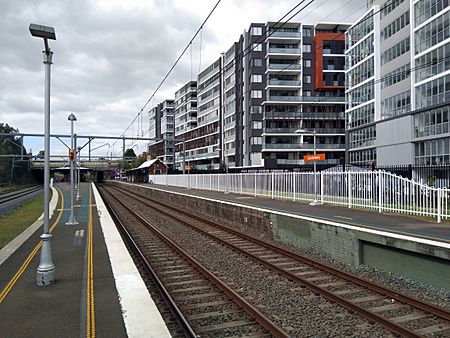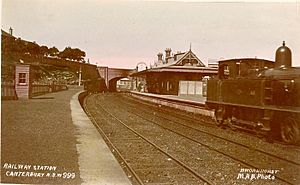Canterbury railway station, Sydney facts for kids
Quick facts for kids
Canterbury
|
||||||||||||||||||||||||||
|---|---|---|---|---|---|---|---|---|---|---|---|---|---|---|---|---|---|---|---|---|---|---|---|---|---|---|
| Sydney Trains commuter rail T3 Bankstown line |
||||||||||||||||||||||||||

View from Platform 1 in 2018
|
||||||||||||||||||||||||||
| Location | Canterbury Road, Canterbury Australia |
|||||||||||||||||||||||||
| Coordinates | 33°54′43″S 151°07′06″E / 33.911877°S 151.118347°E | |||||||||||||||||||||||||
| Elevation | 13 metres (43 ft) | |||||||||||||||||||||||||
| Owned by | Transport Asset Holding Entity | |||||||||||||||||||||||||
| Operated by | Sydney Trains | |||||||||||||||||||||||||
| Line(s) | Bankstown | |||||||||||||||||||||||||
| Distance | 10.16 km (6.31 mi) from Central | |||||||||||||||||||||||||
| Platforms | 2 side | |||||||||||||||||||||||||
| Tracks | 4 | |||||||||||||||||||||||||
| Connections | Bus | |||||||||||||||||||||||||
| Construction | ||||||||||||||||||||||||||
| Structure type | Ground | |||||||||||||||||||||||||
| Platform levels | 1 | |||||||||||||||||||||||||
| Parking | Onstreet parking only | |||||||||||||||||||||||||
| Bicycle facilities | Bike Locker available | |||||||||||||||||||||||||
| Disabled access | No | |||||||||||||||||||||||||
| Other information | ||||||||||||||||||||||||||
| Status | Staffed | |||||||||||||||||||||||||
| Station code | CTB | |||||||||||||||||||||||||
| Website | Transport for NSW | |||||||||||||||||||||||||
| History | ||||||||||||||||||||||||||
| Opened | 1 February 1895 | |||||||||||||||||||||||||
| Electrified | 1926 | |||||||||||||||||||||||||
| Traffic | ||||||||||||||||||||||||||
| Passengers (2018) | 6,150 (daily) (Sydney Trains, NSW TrainLink) | |||||||||||||||||||||||||
| Services | ||||||||||||||||||||||||||
|
||||||||||||||||||||||||||
| Official name | Canterbury Railway Station group | |||||||||||||||||||||||||
| Type | State heritage (complex / group) | |||||||||||||||||||||||||
| Designated | 2 April 1999 | |||||||||||||||||||||||||
| Reference no. | 1109 | |||||||||||||||||||||||||
| Type | Railway Platform/ Station | |||||||||||||||||||||||||
| Category | Transport - Rail | |||||||||||||||||||||||||
| Builders | J. J. Scouller | |||||||||||||||||||||||||
|
||||||||||||||||||||||||||
| Location | ||||||||||||||||||||||||||
Canterbury railway station is a historic train station in Canterbury, New South Wales, Australia. It's part of the Bankstown line and is served by Sydney Trains T3 Bankstown line services. The station was designed by the New South Wales Government Railways and built between 1895 and 1915. It's also known as the Canterbury Railway Station group. Because of its history and design, the station was added to the New South Wales State Heritage Register in 1999. This means it's an important place to protect for future generations.
Contents
History of Canterbury Station
Canterbury station opened on February 1, 1895. It was part of a new railway line built from Sydenham to Belmore. This line was planned to help ease train traffic on another busy line. It also aimed to encourage farming and new towns to grow.
The most important stations on this new line, like Canterbury, Belmore, and Marrickville, were built with impressive brick buildings. Other smaller stations had simpler wooden buildings at first. The railway line was later extended to Bankstown in 1909. This helped connect more growing suburbs.
Goods Line and Signal Box
In 1915, Canterbury Station was made bigger. This was because a new Metropolitan Goods line was being built nearby. This goods line was for freight trains, not passengers.
Next to the station, there are two tracks that are part of the goods line. One of these tracks used to have a platform for special trains. These trains were used for people going to the Canterbury Park Racecourse.
The Canterbury signal box was also built in 1915. A signal box is a building where railway workers control train movements. They use levers to change signals and tracks. This signal box helped control trains on both the passenger line and the goods line.
The signal box was updated over the years with new sections added in 1937 and 1968. However, it was closed down in 1996. The railway authorities decided to keep it exactly as it was when it closed. This helps preserve its history and shows how train signals used to work. Now, signals at Canterbury are controlled from a different location.
Train Services
Canterbury is a local station. This means that most express trains usually don't stop here. However, some trains during busy morning hours do stop at Canterbury.
Platforms and Connections
The station has two platforms:
- Platform 1: For trains heading towards Central and the City Circle (Sydney's city train loop).
- Platform 2: For trains heading towards Lidcombe and Liverpool via Bankstown.
Station Buildings and Features
Canterbury Station has several important parts. These include two main platform buildings, an overhead booking office, and a signal box. There are also canopies, an overbridge, and a footbridge.
Platform Buildings
- Platform 1 Building (1895): This building is made of different coloured bricks. It has a sloped roof and a covered area (awning) that sticks out. The building has old-style windows with coloured glass. Inside, it used to have a booking office and waiting rooms. These areas are now closed to the public.
- Platform 2 Building (1915): This building is also made of brick with a sloped roof and an awning. It's a bit simpler than the Platform 1 building. It used to have waiting rooms and toilets. The waiting rooms still have their original ceilings.
Other Structures
- Overhead Booking Office: This is the main office where you can buy tickets. It's a newer building from the late 1980s. It also has a small shop.
- Signal Box (1915): This two-story wooden building is next to the tracks. It has sliding windows on the top floor. Inside, it used to hold the levers and equipment for controlling train signals. It's kept in its original state to show how old signalling systems worked.
- Platforms: Both platforms have an asphalt surface. They still have their original brick edges.
- Footbridge (1915): This bridge helps people cross over the tracks. It has been updated over the years with a new floor and railings.
- Overbridge (around 1917): This bridge carries Canterbury Road over the railway tracks. It's made of steel and brick.
- Canopies: These are new steel and metal roofs added in the late 1980s. They cover the stairs and parts of the platforms.
Condition of the Station
Most parts of the station are in good condition. The old platform buildings still have many of their original features. The signal box is especially well-preserved. When it closed in 1996, it was sealed to keep all its old equipment safe. This makes it a great example of early 1900s railway technology.
Transport Connections
Canterbury station is a hub for local buses. Several bus routes stop here, connecting the station to other parts of Sydney.
- From Broughton Street Terminus:
- 428: To Martin Place
- L28: To Martin Place (limited stops, only during busy times)
- 487: To Bankstown Central Shopping Centre
- From Canterbury Road stop:
- 445: To Balmain
- 491: To Hurstville
Canterbury station is also served by one NightRide bus route:
- N40: From East Hills station to City (Town Hall)
Why Canterbury Station is Important
Canterbury Railway Station is important for several reasons:
- Historical Significance: It shows how railways helped Sydney grow in the late 1800s and early 1900s. The Platform 1 building shows the change in railway building design during that time. The signal box also shows how train signalling technology developed.
- Design and Beauty: The Platform 1 building is a great example of the beautiful design of railway buildings from before 1900. It has special brickwork and decorations. It's similar to other important stations like Marrickville and Belmore.
- Learning Opportunity: The signal box is still in its "as working" condition. This means it can teach us a lot about how old railway signalling systems operated.
- Community Connection: The station helps connect the local community to its past and history.
- Rarity: The design of the signal box building is quite rare in the Sydney area.
The station was added to the New South Wales State Heritage Register on April 2, 1999.
Images for kids




